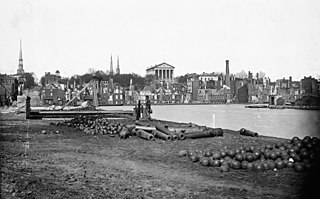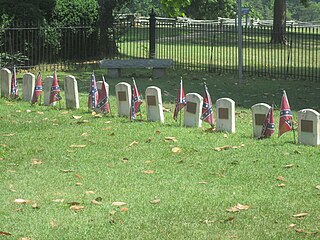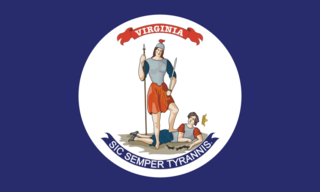
Hollywood Cemetery is a large, sprawling cemetery located next to Richmond, Virginia's Oregon Hill neighborhood at 412 South Cherry Street. Characterized by rolling hills and winding paths overlooking the James River, it is the resting place of two United States Presidents, James Monroe and John Tyler, as well as the only Confederate States President, Jefferson Davis. It is also the resting place of 28 Confederate generals, more than any other cemetery in the country; these include George Pickett and J.E.B. Stuart.

Hunter Holmes McGuire was a soldier, physician, teacher, and orator. McGuire was a surgeon in the Confederate Army attached to Stonewall Jackson's command, and he continued serving with the Army of Northern Virginia after Jackson's death. He started several schools and hospitals which later became part of Virginia Commonwealth University in Richmond, Virginia. McGuire was later president of the American Medical Association. His statue sits prominently on the grounds of the Virginia State Capitol. Nearby, the McGuire Veterans Administration Medical Center is named in his honor.
Sally Louisa Tompkins was a humanitarian, nurse, philanthropist and the first woman to have been formally inducted into an army in American history. Many believe that she was also the only woman officially commissioned in the Confederate Army. She is best-remembered for privately sponsoring a hospital in Richmond, Virginia to treat soldiers wounded in the American Civil War. Under her supervision she had the lowest death rate of any hospital Union or Confederate, during the Civil War. She has been remembered as the "Angel of the Confederacy".

The Richmond National Battlefield Park commemorates 13 American Civil War sites around Richmond, Virginia, which served as the capital of the Confederate States of America for most of the war. The park connects certain features within the city with defensive fortifications and battle sites around it.
Contraband was a term commonly used in the US military during the American Civil War to describe a new status for certain people who escaped slavery or those who affiliated with Union forces. In August 1861, the Union Army and the US Congress determined that the US would no longer return people who escaped slavery who went to Union lines, but they would be classified as "contraband of war," or captured enemy property. They used many as laborers to support Union efforts and soon began to pay wages.

Phoebe Yates Levy Pember was a member of a prominent American Jewish family from Charleston, South Carolina, and a nurse and female administrator of Chimborazo Hospital at Richmond, Virginia during the American Civil War. She assumed the responsibility informally at the age of 39 and eventually over 15,000 patients came under her direct care during the war.

The American state of Virginia became a prominent part of the Confederacy when it joined during the American Civil War. As a Southern slave-holding state, Virginia held the state convention to deal with the secession crisis, and voted against secession on April 4, 1861. Opinion shifted after the Battle of Fort Sumter on April 12, and April 15, when U.S. President Abraham Lincoln called for troops from all states still in the Union to put down the rebellion. For all practical purposes, Virginia joined the Confederacy on April 17, though secession was not officially ratified until May 23. A Unionist government was established in Wheeling and the new state of West Virginia was created by an act of Congress from 50 counties of western Virginia, making it the only state to lose territory as a consequence of the war.

Richmond, Virginia served as the capital of the Confederate States of America for almost the whole of the American Civil War. Notwithstanding its political status, it was a vital source of weapons and supplies for the war effort, as well as the terminus of five railroads, and as such would have been defended by the Confederate States Army at all costs.

Oakwood Cemetery is a large, city-owned burial ground in the East End of Richmond, Virginia. It holds over 48,000 graves, including many soldiers from the Civil War.

The city of Winchester, Virginia, and the surrounding area, were the site of numerous battles during the American Civil War, as contending armies strove to control the lower Shenandoah Valley. Winchester changed hands more often than any other Confederate city.

A large contingent of African Americans served in the American Civil War. The 186,097 black men who joined the Union Army included 7,122 officers and 178,975 enlisted soldiers. Approximately 20,000 black sailors served in the Union Navy and formed a large percentage of many ships' crews. Later in the war, many regiments were recruited and organized as the United States Colored Troops, which reinforced the Northern forces substantially during the conflict's last two years. Both Northern Free Negro and Southern runaway slaves joined the fight. Throughout the course of the war, black soldiers served in forty major battles and hundreds of more minor skirmishes; sixteen African Americans received the Medal of Honor.

Chimborazo Park is a park and historic land site in Richmond, Virginia, United States. Created in 1874, the park was the site of Chimborazo Hospital, one of the world's largest military hospitals.

Sailor's Creek Battlefield Historical State Park is a 321-acre (130 ha) state park near Rice, Virginia, located mostly in Amelia County with a small portion in Prince Edward County. It includes a portion of the landmarked Sayler's Creek Battlefield, an area of 1,022 acres (414 ha) that was the site of the April 6, 1865 Battle of Sayler's Creek, one of the last major engagements in the Eastern Theater of the war involving Confederate General-in-Chief Robert E. Lee (1807-1870). The battle occurred during his week-long retreat to the southwest in the final Appomattox campaign from the fallen Confederate capital at Richmond and nearby Petersburg, three days before his surrender at Appomattox Court House to Union Army General-in-Chief Ulysses S. Grant (1822-1885), which effectively ended the American Civil War (1861-1865).

The Appomattox Court House National Historical Park cemeteries are part of the Appomattox Court House National Historical Park, which was listed on the National Register of Historic Places on June 26, 1989.

The state of medical knowledge at the time of the Civil War was extremely primitive. Doctors did not understand infection, and did little to prevent it. It was a time before antiseptics, and a time when there was no attempt to maintain sterility during surgery. No antibiotics were available, and minor wounds could easily become infected, and hence fatal. While the typical soldier was at risk of being hit by rifle or artillery fire, he faced an even greater risk of dying from disease.

The 42nd Virginia Infantry Regiment was an infantry regiment raised in Virginia for service in the Confederate States Army during the American Civil War. It fought mostly with the Army of Northern Virginia.

VCU Medical Center is Virginia Commonwealth University's medical campus located in downtown Richmond, Virginia in the Court End neighborhood. VCU Medical Center used to be known as Medical College of Virginia (MCV), which merged with Richmond Professional Institute in 1968 to create Virginia Commonwealth University. In the 1990s, an authority controlling MCV Hospitals was created called the Medical College of Virginia Hospitals Authority. In 2004, the name of this authority was changed to VCU Health System and the MCV Hospitals and surrounding campus were branded VCU Medical Center. This authority controls the employees and real estate occupied by the five schools within the VCU Medical Center. It was at this time that the MCV Campus moniker was created. West Hospital houses various clinical, administrative and support services of the hospitals of VCU Medical Center; clinical, academic and administrative units of the School of Medicine; and academic and administrative units of the School of Allied Health Professions.

The Stone House, Manassas National Battlefield Park, is a two-story, stone structure in Prince William County, Virginia. It was built as a stop on the Fauquier and Alexandria Turnpike in 1848. During the American Civil War, The Stone House served as a hospital during the First and Second Battles of Manassas.

Juliet Ann Hopkins was born on a plantation in Jefferson County, Virginia. After her marriage to Arthur F. Hopkins of Mobile, Alabama, she relocated to that state. During the Civil War, the couple sold most of their real estate holdings and donated the money to the cause of the Confederate States of America. When her husband was appointed to oversee hospitals during the war, she went to work converting tobacco factories into hospitals. She made daily visits to the wounded, and received a battlefield injury in the course of her duties.

Walter Drew McCaw was a career officer in the United States Army. A medical doctor, he served as an army surgeon and attained the rank of brigadier general. A veteran of the Spanish–American War, Philippine–American War, and World War I, he was a recipient of the Army Distinguished Service Medal and Silver Star in addition to several foreign decorations.






















